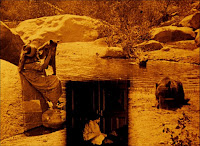Outside of Miss Talmadge there isn't an awful lot to
"The Song of Love." It is another of those desert stories, the same
type more or less that went out of fashion a little over a year ago…
The Variety reviewer (1) wasn’t pulling any
punches about this film or even it’s undoubtedly very popular star – the highest
paid female actor at the time – although he was considerably impressed with her
revealing costume. The New York Times - Mordaunt Hall? -concurred on
both film and the newly discovered Talmadge torso, a step away from her usual “demure”
roles…
Imagine passing into the Rivoli with a vague
impression of Miss Talmadge in poke bonnet and voluminous hoop skirts that
jealously guard even her ankles from view, and suddenly beholding a startling
vision of undeniable beauty, clad expensively, but not extensively.
Film Daily felt Norma looked ill at ease in the
revealing costume – she certainly didn’t wear anything so skimpy again – but
perhaps all of this shows that even though a highly competent and versatile
star, the public had an expectation of what a Norma Talmadge film should be.
 |
| Norma's saying no to Arthur Carewe |
All this said, Norma Talmadge is likeable in every film I’ve
seen her in and, whilst F Scott Fitzgerald described her as the epitome of glamour
in Tender is the Night, he also wrote that she must be a fine noble woman
beyond her loveliness. Maybe Norma’s just too nice for modern tastes?
 |
| Too nice? |
 |
| New romantic or glam? Joseph Schildkraut |
The local colonial notables, Commissionaire Desmond (Earl Schenck), Captain Fregonne (Mario Carillo), Dr. Humbert (James Cooley) and their American friend Dick Jones (Laurence Wheat) from Grand Rapids, Michigan, USA… have gotten wind of the plotting and called in French agent Ramon Valverde (Joseph Schildkraut) but, round these parts, it’s not just walls that have ears but curtains too with Ramlika’s spy, Chamba (Albert Prisco) hearing the whole plan.
Valverde is no mug though and makes his first appearance
in disguise looking something like Spandau Ballet’s bass player in 1983 as he
listens in to the Tuareg’s plans at the gambling den. He doesn’t go unnoticed by
our dancing heroine who ignores his make up sensing the goodness of the man
inside. Ramlika isn’t impressed and the two men fight with Valverde making good
his escape and deciding to use Noorma-hal’s attraction to him to keep tabs on
the uprising.
 |
| Maude Wayne as the Other Woman |
Whilst all’s fair in love and war, Valverde goes on to
show us his moral fibre when he refuses to rekindle an old affair with the
Commissioner’s wife Maureen (Maude Wayne). But Noorma-hal catches them in the
act of not continuing and assumes, correctly based on his previous thinking, that
he only wants the white Christian woman. Passions are, however, on the rise and
Noorma-hal is soon stuck between a frog and a hard face as she must decide who
to betray and when. The Tuareg forces are massing and only she can stave off
disaster but, at what cost to herself?!
As the above reviews indicate even at the time this was an
old tale and whilst there are twists and turns, they are mostly predictable.
What saves it is Norma who is nearly always in the moment and the only really
relatable character throughout.
I watched the film on the Kino Lorber Blu-ray set,
Pioneers: First Women Filmmakers (4) which uses the German print which has
a different ending from the US print – which is explained via title card and
which is the more surprising conclusion for a number of reasons. The print quality
is mostly excellent but there is some deterioration which Greta de Groat says
is not present on the other surviving print held at the Library of Congress but
you can’t have it all - it's a mostly fine looking
film and inspite of the gripes, who doesn't like watching Norma T work even if it's mostly so much sand and fury signifying very little.
1. Greta de Groat’s excellent website has a wealth of Norma information and links to the
World-Wide-Web of Talmadge – I lifted the Variety and NYT quotes
from her!
2. Writing
in Idols of Modernity: Movie Stars of the 1920s, Rutgers University Press (2010)
3. Jeanine
Basinger – Silent Stars, Wesleyan University Press (2000)
4. The
six Blu-ray set Pioneers: First Women Filmmakers is of course essential
and available direct from Kino Lorber as well as via Amazon.com – anyone else
finding that export restrictions are being tightened recently?



















































+colour.png)








